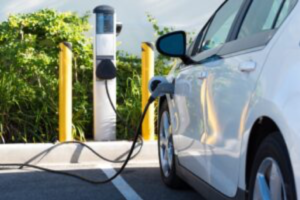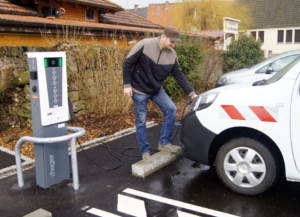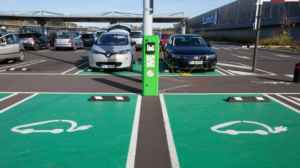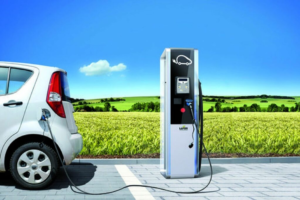Optimizing the public charging
station network
In 2024, all French municipalities must have 5% of parking spaces with electric car charging stations. Far from being a punitive regulatory constraint, this measure is actually a source of many opportunities. In addition to the economic benefits, it can contribute to improve the ecological footprint and the social life of communities. M@Air explains you why and presents you its solution to optimize the distribution of charging stations in your community.
The obligation to install charging stations for electric cars: a boon for municipalities
Ecological value
It goes without saying that the first advantage of this measure is ecological. In the future, any citizen will be able to charge an electric vehicle as easily as filling up a thermal vehicle today. In the long term, this should encourage the use of electric or hybrid cars for both short and long distances.
Positive economic spin-offs
Charging with electric current is three to four times cheaper per km than going to the pump. It is therefore in the interest of local authorities to make it easier for their citizens to charge their electric cars. It's as good for the planet as it is for their purchasing power!
In addition, the terminals have positive effects on the attractiveness of the territories. For example, businesses that have outlets near their premises tend to see an increase in traffic. A similar growth can be observed when bicycle parking is provided near businesses.
Support for the planning of charging stations
Several grants are available to help communities deploy a network of electric car plugs. The main device is the prime ADVENIR issued by the ADEME. This covers up to 40% of the cost of installing the terminals, with a ceiling set at €2,160 per terminal.

© MICHAEL FLIPPO, ADOBE STOCK
The importance of a planned distribution of electric car charging stations
Making low-carbon mobility available to all
The first issue in a planned distribution of electric car charging stations is the need to contribute to a greater equal access to electromobility. According to ADEME, there are great disparities in charging practices depending on the type of housing: 90% of the inhabitants of individual houses recharge their vehicles at home, as opposed to only 54% of apartment building residents. The priority is to target parking lots located in neighborhoods with a majority of apartment buildings, particularly in social housing areas.
Risks associated with poor planning
It's not enough to install plugs for electric cars to see the number of electric cars soar overnight. A arbitrary planning risks slowing down the transition towards decarbonized mobility in a territory. Indeed, if we blindly follow the directive of 5% of electric car spaces per parking lot, we run the risk of installing too much in some places and not enough in others in relation to actual needs.
Another risk is that of price of electricity used to charge vehicles, that vary significantly from one supplier to another. Communities must therefore ensure that they select suppliers that remain affordable for users.

M@Air solution: affordable terminals that meet the real needs of users
Minimal investment, optimized distribution
The solution proposed by M@Air is based on two pillars:
1. Minimize the initial investment in charging stations of electric cars by opting for 3.7 kW/h "sustainable" terminals instead of the "fast" 22 kW/h terminals. The total cost of the first ones is 250 € per socket against about 1000 € for the second ones.
This choice is based on the reality of users' daily lives, where the car remains, in general, immobilized 90% of the time. However, a station of 3.7 kW/h allows a Zoe to be recharged in 2 hours for 40 km of autonomy. The user will be able to recharge his battery sufficiently during the night in the public parking lot closest to his home. If he has the possibility to charge his battery at his workplace, he will be able to complete the charge of his battery during the day for his return trip, if necessary.
2. Distribute electric car plugs in an optimized way taking into account the reality of a territory: the neighborhoods with a majority of buildings, the cover in public transportation, the employment areas present, etc. in order to maximize their use.
« Even if [the network of electric car charging stations] shows a significant growth rate (+49% in one year), the perceived lack of charging stations in the territory remains a major obstacle to the deployment of electro-mobility. » (ADEME Opinion October 2022) « Democratizing the electric car requires a balanced recharging network that is accessible to all. » (Idem)

In practice: Electromobility accessible to all
Let's take the case of a municipality of 30,000 inhabitants in the western part of the Île-de-France region that called on us. As part of our study, we conducted two distribution simulations. On the one hand, a purely arithmetical distribution: 5% of terminals in each parking lot. On the other hand, a distribution based on a scientific analysis of the reality of the territory. We have thus crossed numerous demographic and socio-economic data, while taking into account the geography of the city.
The results are indisputable. The first scenario would lead to a lack of places in all parking lots, except one where there would be 22 too many. In the second scenario, on the other hand, we managed to allocate sufficient places to meet the needs of residents.
In terms of costs, the difference is also clear for the municipality. A breakdown not optimized would have required an investment of 400.000 €. Following our optimized scenario, the municipality will only have to spend 200 000 € approximately.

As we have seen, choosing the wrong provider can lead to excessive and unnecessary expenses for a community. In addition, fast electric car charging stations (>22kW/h), more attractive at first glance to the consumer, are less energy efficient. The choice of these charging stations, rather than "sustainable" ones (3.7 kW/h), may therefore, in the long run, have a greater ecological impact.
It is therefore preferable to turn to an actor like M@Air. We take care of the planning of the stations and accompany the communities in their installation from A to Z. This includes, of course, the selection of quality service providers for the installation and the power supply of the terminals. We make sure that the rates are adapted to the resources of the communities.
You represent a municipality, an EPCI or a metropolis? M@Air accompanies you in the distribution and installation of your electric car charging stations. Contact us to tell us about your current call for tenders. We will come back to you as soon as possible to set the basis of your project.
